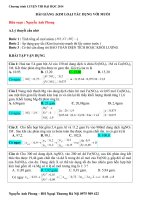- Trang chủ >>
- THPT Quốc Gia >>
- Ngữ Văn
Cach nhan biet tu loai
Bạn đang xem bản rút gọn của tài liệu. Xem và tải ngay bản đầy đủ của tài liệu tại đây (55.08 KB, 2 trang )
<span class='text_page_counter'>(1)</span>CÁCH NHẬN BIẾT TỪ LOẠI TRONG CÂU I. Nouns ( Danh từ ) 1. Chủ ngữ → Thường đứng đầu câu or sau trạng ngữ chỉ thời gian History is my favorite subject Yesterday, he went home at midnight 2. Sau adj → my, your, our, their, his, her, its, good, beautiful, …….. She is a beautiful girl His father works in the factory 3. Làm tân ngữ, sau động từ He likes English They are students 4. Sau “ enough ” He didn’t have enough money to buy a new computer 5. Sau các mạo từ: a, an, the hoặc các từ this, that, these, those, each, every, both, no, some, any, few, a few, little, a little, …. ( Chú ý cấu trúc: …. a/ an/ the + adj + N ) This book is an interesting book I take both milk and sugar in my coffee 6. Sau prep: in, on, of, with, under, about, at, ……… My friend is good at Maths She arrived before lunch II. Adjectives ( Tính từ ) 1. Trước danh từ → Adj + N Celine Dion is a famous singer 2. Sau động từ liên kết: → be, seem, appear, feel, taste, look, keep, get, sound, smell, stay, … + adj She is pretty Tom seems tired now Note: Cấu trúc: keep/ make + O + adj He makes me happy 3. Sau “ too “ → S + to be/ seem/ look/ feel, … + too + adj … He is too young to drive a car 4. Trước “ enough “ → S + to be + adj + enough She isn’t old enough to be in my class 5. Trong cấu trúc “ so … that “ → tobe/ seem/ look/ feel/ taste … + so + adj + that The soup tastes so good that everyone will ask for more 6. Trong các dạng so sánh Meat is more expensive than fish Huyen is the most intelligent student in my class 7. Trong câu cảm thán → How + adj + S + V! What + (a/an) + adj + N! How pretty she is! What a beautiful house! III. Adverbs ( Trạng từ ) 1. Trước động từ thường ( đb là adv tần suất: often, always, usually, seldom, …) They often get up at 6 a.m 2. Giữa trợ động từ & động từ thường I have recently finished my homework 3. Sau tobe/ seem/ look … và trước adj → tobe/ seem/ look … + adv + adj She is very nice 4. Sau “ too “ → Vth + too + adv He speaks too quickly for us to understand 5. Trước “ enough “ → Vth + adv + enough The teacher speaks slowly enough for us to understand 6. Trong cấu trúc “ so … that “ → Vth + so + adv + that.
<span class='text_page_counter'>(2)</span> He speaks English so well that I thought he was a native speaker 7. Đứng cuối câu The doctor told me to breathe in slowly 8. Cũng thường đứng một mình ở đầu câu, hoặc giữa câu và cách các thành phần khác bằng dấu ( , ) Last summer, I came back my home country My parents had gone to bed when I got home It’s raining hard. Tom, however, goes to school IV. Verbs ( Động từ ) Thường đứng sau chủ ngữ ( chú ý với câu có nhiều mệnh đề ) My family has five people I believe her because she always tells the truth Cách nhận biết từ loại 1. Nouns: - tion/ - ation, - ment, - er, - or, - ant, - ing, - age, - ship, - ism, - ity, - ness → distribution, information, development, teacher, actor, accountant, teaching, shortage, friendship, socialism, ability, sadness 2. Adjectives: - ful, - less, - ly, - al, - ble, - ive, - ous, - ish, - y, - like, - ic, - ed, - ing → helpful, homeless, friendly, national, acceptable, active, famous, selfish, rainy, childlike, bored, boring 3. Adverbs: Thường adj + ly Beautifully, carefully, badly, usefully Một số adv đặc biệt: good → well late → late/ lately ill → ill/ illy fast → fast hard → hard early → early.
<span class='text_page_counter'>(3)</span>









